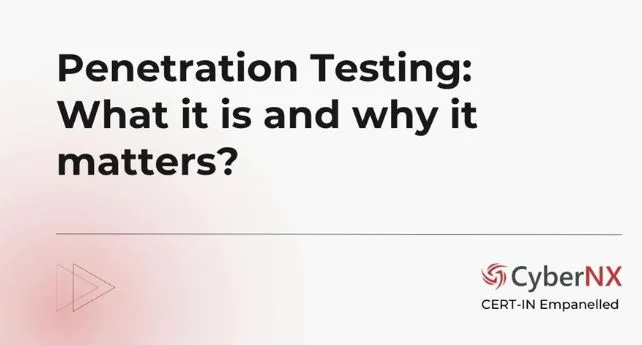Beyond the Scan: How Penetration Testing Reveals the Gaps You Can’t Miss
It almost feels like cyber attackers are running rampant in 2025. Every day, you hear about millions of dollars of losses due to data breach, businesses shutting down due to operational disruption and sensitive data being leaked.
Comprehensive penetration testing throughout the year can help businesses of all sizes to defend and fight against cyberattacks.
CyberNX’s expert-led pentesting services can assist your internal security teams by revealing security gaps and fixing them before threat actors can get their hands on them to conduct nefarious activities.
What is Penetration Testing?
Pentesting is a company leadership authorized, controlled exercise where pentesters use advanced tools to simulate real world attacks on your digital systems. Depending on your requirement, entire assets are tested or those which are a priority.
The professional pen tester gets into the shoes of a hacker. The testing process is then so designed to find exploitable vulnerabilities and show the possible path a hacker could take to compromise critical assets, steal data or disrupt your business operations.
Moreover, pentesting helps your organization build a roadmap or remediation measures to mitigate and protect your most critical digital assets from present and future cyberattacks.
How Penetration Testing Differs from Vulnerability Scans
Now that you know what penetration testing is, find out how it is different from vulnerability scans. Although, both improves security posture of your organisation, they vastly differ in their approaches and outcomes.
- Depth vs Breadth: Vulnerability scanning of systems and networks are fast and broad, highlighting potential issues based on known signatures. Pentesting, on the other hand, go deeper, chaining vulnerabilities together to show real impact.
- Validation: While a scanner can flag a missing patch in the system, pentesting shows how that missing patch could lead to privilege escalation.
- Context Awareness: Scanners completely lack context with no understanding of business logic or abuse cases. Pentesters, meanwhile, quickly adapt to different environments, discovering new attack paths.
Benefits: Why Penetration Testing Matters
Cyberattacks have achieved sophistication and advancement at a whole new level. This demands organizations to invest in offensive security testing and reap its benefits.
1. Penetration Testing Uncover What Matters
Not all vulnerabilities are equal. There are known vulnerabilities (CVEs) and unknown. Pentesting helps prioritize by revealing those with real world impact.
2. Validate Security Defences
Pentesting helps your organisation understand if your security stack and response teams will be able to detect and stop advanced and modern threats.
3. Comply with Confidence
Regulations like PCI DSS, ISO 27001 and RBI guidelines have become stricter and mandate periodic penetration tests. Your organization can be confident of compliance with regular pentesting.
4. Protect Brand and Reputation
Once a data breach occurs, it can have drastic consequence on brand reputation. Plus, it can erode customer trust. Testing strengthens your defences proactively.
5. Empower Security Decisions
Real-world attack simulations done as a part of pentesting helps IT managers and CISOs justify security investments with tangible risk insights in the boardroom.
Types of Penetration Testing
Your IT infrastructure may consist of web and mobile apps, cloud, IoT devices and more. Therefore, the nature of testing depends on what needs protecting.
1. Web Application Testing
Identifies flaws like SQL injection, broken authentication and IDOR vulnerabilities in the public-facing or internal applications.
2. Mobile Application Testing
Looks into mobile-specific threats, insecure storage, API misconfigurations and reverse engineering risks.
3. Network Penetration Testing
Focuses on internal and external network infrastructure, that include firewalls, routers, and servers, for entry points and pivot paths.
4. Cloud Penetration Testing
Covers misconfigured IAM policies, exposed storage buckets and cloud-native attack paths in platforms like AWS, Azure, and GCP.
5. API Security Testing
Evaluates API endpoints for data leakage, authorization flaws and injection vulnerabilities.
6. Social Engineering Testing
Phishing, pretexting and other psychological attack techniques are used to assess how employees respond to manipulation.
7. IoT Penetration Testing
Targets connected devices and their ecosystems with the purpose of examining firmware, APIs, communication protocols and cloud integration for flaws.
How CyberNX Delivers Value Through Certified, Real-World Simulations
At CyberNX, the team of experts use cutting-edge tools to identify systems components with severe risk and offer meaningful and actionable insight in quickest time possible.
This helps organizations in several ways such as to:
- Find vulnerabilities before hacker could
- Plug compliance gaps
- Assess the response time of your security team
- Understand potential effects of a cyberattack on the business
- Take Remediation measures
In addition, our security team holds must-have certifications like OSCP, CEH, CISSP, and simulate modern attackers smartly with persistence and intent.
Our methodology also reflects real world threat actor behaviour, from reconnaissance and exploitation to post-exploitation plus using the latest TTPs (tactics, techniques, and procedures). As for pentesting report, you get a strategic roadmap to fix what matters most.
CyberNX integrates findings into your broader security posture, aligning results with risk appetite, compliance mandates, and business goals.
Why CERT-IN Empanelment Matters
CyberNX is CERT-IN empanelled. What it signifies is that we are authorized by India’s top cybersecurity agency to conduct audits and penetration tests for critical and regulated sectors. This adds credibility and ensures adherence to national standards, especially important for sectors handling sensitive data or operating under government oversight.
Industries We Serve
As each industry has unique attack surfaces and risk profiles, CyberNX specializes in delivering contextual security assessments across:
- BFSI (Banking, Financial Services, and Insurance): Simulating fraud tactics, insider threats, and SWIFT-related risks.
- Fintech: Assessing mobile apps, APIs, payment gateways, and authentication mechanisms.
- SaaS Providers: Evaluating multi-tenant architectures, session controls, and access provisioning.
- Healthcare: Ensuring ePHI protection and HIPAA-aligned testing. Every engagement is rooted in business understanding and attacker mindset.
Conclusion
One of the best things about Pentesting is that it cuts through the noise, delivering actionable insight into how your defences hold up against actual threats. This eventually helps businesses to build a strong cybersecurity defence around your digital environment.
With CyberNX as your penetration testing partner, you can be assured of getting ahead of modern cyber attackers.
In addition, CyberNX secures businesses with 25+ cybersecurity services, certified experts and cutting-edge technology. If you are looking for 360-degree security for your organization, talk to our experts today!
Penetration Testing FAQs
How often should a company conduct pen testing?
The ideal frequency depends on the business’s risk profile, compliance needs, and rate of change. For most organizations, annual tests are the baseline. However, if you frequently release new applications, undergo cloud migrations, or face targeted threats, more frequent or continuous testing is recommended.
Can pen test impact production systems or user experience?
Yes, if not planned correctly. That’s why reputable providers like CyberNX conduct tests in controlled environments or during low-traffic windows. Tests are designed to be non- disruptive, with clear communication and rollback plans in place.
What’s the difference between black box, white box, and grey box testing?
Here’s the difference:
- Black Box: Testers have no prior knowledge, ideal for simulating an outsider’s attack.
- White Box: Full access to code and systems, useful for uncovering deep-seated flaws.
- Grey Box: Partial information is shared to replicate an insider threat or partner risk. Each approach reveals different risk layers.
Is penetration test relevant for startups and small businesses?
Absolutely. Smaller businesses are often targeted precisely because they’re seen as easier to breach. A well-scoped penetration test can uncover major risks early and provide a cost-effective blueprint to strengthen defences before scaling.




